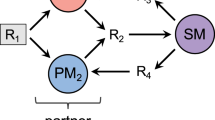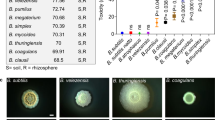Abstract
IN a recent publication1, Jinks has compounded the erroneous impression, first given by Grigg2, that competitive suppression is a neglected source of error in studies of prototrophs or reversions of nutritional requirement in micro-organisms. Kølmark and Westergaard3 have shown that Grigg's criticism is inapplicable to their case; but since Jinks's publication is subsequent to this, and expresses the belief that “it is not easy to see a simple way of avoiding [the] effects” of competitive suppression, a brief recollection of the facts published elsewhere on the matter seems called for. Competitive suppression is certainly a real phenomenon and has been studied experimentally in some detail4–6. The findings relevant to the present issue are that: (1) the addition of prototrophs to the culture of organisms from which prototrophs it contains are being screened measures the extent of competitive suppression; (2) when competitive suppression is not acting, dilution of the culture results in a corresponding decrease in the number of prototrophs, and added prototrophs are recovered.
This is a preview of subscription content, access via your institution
Access options
Subscribe to this journal
Receive 51 print issues and online access
$199.00 per year
only $3.90 per issue
Buy this article
- Purchase on Springer Link
- Instant access to full article PDF
Prices may be subject to local taxes which are calculated during checkout
Similar content being viewed by others
References
Jinks, J. L., Nature, 170, 106 (1952).
Grigg, G. W., Nature, 169, 98 (1952).
Kølmark, G., and Westergaard, M., Nature, 169, 626 (1952).
Ryan, F. J., Cold Spring Harbor Symp., 11, 215 (1946).
Ryan, F. J., and Schneider, L. K., Genetics, 34, 72 (1949).
Ryan, F. J., and Schneider, L. K., J. Bact., 58, 201 (1949).
Nelson, T. C., Genetics, 36, 162 (1951).
Newcombe, H. B., and Nyholm, M. H., Amer. Nat., 84, 457 (1950).
Newcombe, H. B., and Hawirko, R., J. Bact., 57, 565 (1949).
Giles, N. H., Cold Spring Harbor Symp., 16, 283 (1951).
McElroy, W. D., and de la Haba, G., Science, 110, 64 (1949).
Author information
Authors and Affiliations
Rights and permissions
About this article
Cite this article
RYAN, F. Competitive Suppression of Prototrophs. Nature 171, 400–401 (1953). https://doi.org/10.1038/171400b0
Issue Date:
DOI: https://doi.org/10.1038/171400b0
Comments
By submitting a comment you agree to abide by our Terms and Community Guidelines. If you find something abusive or that does not comply with our terms or guidelines please flag it as inappropriate.



